DXing Vacation in Caribbean Island
By Jun'ichi Ohgo, VP5/JJ1BMB, re-edited version
of the article excerpted from "59" magazine Oct. 24, 1993
Summary
This article describes the pleasure of my DXfing vacation in Caribbean Island, called gTurks & Caicos islands*h,
partnering with JM1GYQ, Mr. Okamoto, working on 80 m through 10 m band and even satellite
communication as well as CW, SSB and RTTY modes.
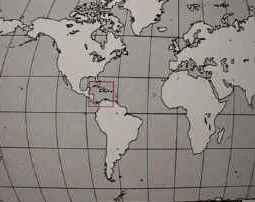
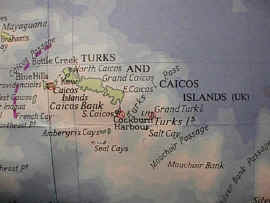
Turks & Caicos Islands: 573 miles south-east
of Miami, Florida,
Link to http://www.interknowledge.com/turks-caicos/
Overview
Overall, the 3,346 of QSO was logged in our note by our
two-men-operation in Caribbean island from Sept. 16 through 20th f94, on 80 m band through 10 m band including the satellite
communication. The HF band opening to JA in the island barely happened, so the number of
QSO with JA stations was a few on 17 m and 20 m band in CW and SSB mode. On the other
hand, the satellite QSO by AO-13 was made easily and simply even though the antenna stuff
was not sufficiently set-up. Over 40% of all the satellite QSO was JAs, since the band is
less QRM and QRN than HF bands, and it is distinctively stable, compared to HF band
condition in this period. So we have really enjoyed a ragchew-ing in Japanese with JAs via
the satellite.
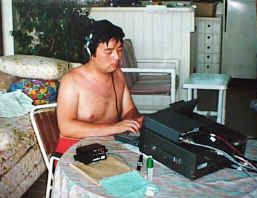
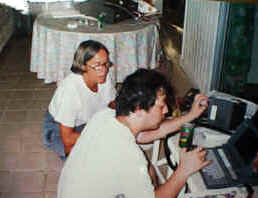
VP5/JJ1BMB is operating 18MHz.@@@uoTil
Jody and VP5/JJ1BMB (Satellite).
Propagation
10 & 12m: Both bands were very quiet. The
number of QSO made here was only a few, which were South American, North American and
European stations.
15 & 20m: Both
bands were open in the afternoon through evening. Signals from North America and Europe
became strong in this time zone. During this opening, some signals even from Africa came
in. Then it became quiet toward the mid night through the morning.
40 & 80m: It
was obvious that signals of European stations were popping up out of the noise floor in
the mid night, as time goes by, and its gSh
level went up. Thus, we had a great pleasure of piling up by
a number of European station calls, though, we could not deal with QSO 100%, due to the
lack of sleep by all-day-long operation and a jet-lag as well.
In these low bands, such as 75 and 80 m bands, we had
scheduled to work on at 0430Z, 0530Z, 0800Z and in 40 m band, 1100Z, and 0430Z, 0730Z,
0900Z and 2330Z, expecting the band opening to Japan. Although we have watched the bands
in the above time period, we could not make any QSO with JA stations. This was somehow
understood it was too early to make any DX QSO between Caribbean islands and Japan.
In the heavy pile up of US station calls on 75 m band, an
US station squeezed into my spot frequency, telling us that a New Zealand station was
calling us, though, we could not catch such incoming signal up here unfortunately due to
the heavy noise happened on this band.
Even on 80 m band, we wished to make a QSO with JA
stations, waking up early in the morning before the sun rise, though, we have listened
only a signal that US stations were calling VK9MM. Then, we have called CQ at the adjacent
channel, trying to catch signals from JA up here. All of sudden, a US station suggested us
to get out of this frequency, since VK9MM is sitting near by our spot, causing QRM. This
happening realized me that the QSO between the East Coast and Oceanic countries for US
stations is not so easy as the QSO between Caribbean and Japan.
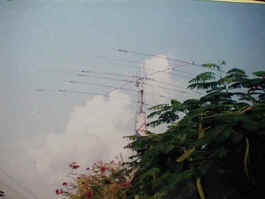
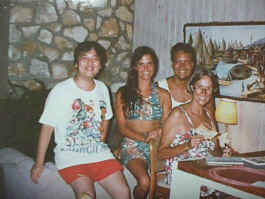
10m/15m/20m Multi Band YAGI. @@@VP5/JJ1BMB
and Jody's family.
US stations, particularly the East Coast
stations, were always strong and dynamic, holding a 10 dB through 20 dB over S9 all the
way on any bands, as well as DX-pedition stations in the Pacific islands bring a strong
signal to Japan. The distance of 1.5 hours by a jet plane from Miami, Florida to the
island, corresponds to the distance between Tokyo and Kyusyu. So this will give you an
easy guess how strong they are.
Satellite communication
First of all, I wished that we were successful on even the
satellite communication as well as the regular QSO with enough equipment. To achieve our
goal, we got the special lesson to work on the satellite band from JA1CG, Mr. Takahashi.
(Special thanks to Takahashi OM!) Owing to his lesson, we were able to get started with
the satellite communication here in this island. However, in the beginning, the down-link
reception was not good due to some problem of the antenna in the first 2 days. So we had
to borrow the other one from Jody, which is a 13 element Yagi by Cushcraft,
horizontally-polarized. Owing to this antenna, we got a successful ending of the satellite
communication in the heavy pile-up causing us to deal with.
In a reality, Jody brought us her antenna, a
13-element Yagi, saved in her house that she used to use that for FM mobile local
contacts. Her courtesy saved our DXfing QSO via the
satellite to JA stations. She had actually opened the window to JA. To tell the background
story, we have slipped our mouth of this trouble in front of her at the dinner table in
the last night before this happening, g We could not
make any QSO with JA due to the poor antenna set up for the down-link, even though we
could catch calling CQ from JAh. She brought us such
an antenna and carried that with her at the place where we worked on in the early morning.
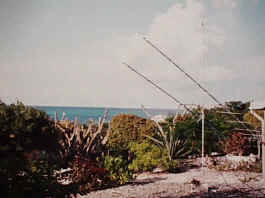
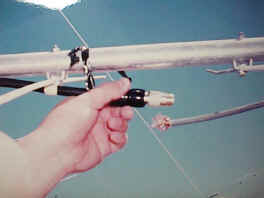
Antennas for Satellite.@@ Antenna connector
connection.
However, we found the mechanical mismatch between her antenna and my cable connector that I have provided,
when setting up the antenna. Her antenna had a UHF connector at the cable end, whereas my
cable had a N-type connector. To link together, I instantly chopped off a N connector out
of my cable by a knife, and tied the cable end to the antenna connector with a vinyl tape
mechanically. After this fixing, and settling the antenna to the right position manually
over the hand made wooden arm, so that the antenna would direct to the right angle and
direction with a horizontal polarization. After all, a down-link reception became so good
to catch any DX signals via the satellite like on 20m band. This set up and our trouble
shooting have really amazed Jody, bringing a number of signals via satellites into her ear
in front of us.
I was aware of her interests on the satellite
QSO, via a telephone conversation prior to the trip. This was certified that even in her
notebook PC, TI made TravelMate with gQuick Trackh
a satellite tracking software already installed, showed her
enthusiasm to enjoy such a satellite communication. Even more than ever, it seemed to me,
what she observed our operation with the trouble shooting all the way, raised up her
confidence, gI can do it by myself, tooh. While I was looking at her face, I said to myself, gWhy donft I give her my
satellite communication stuff, though, I hesitated to think of doing soh. Instead, we promised to have a QSO with her via the satellites in
the future, when were back home. We are really looking forward to having a QSO with her.
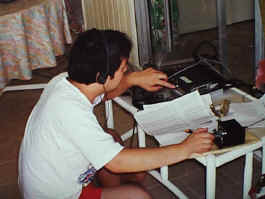
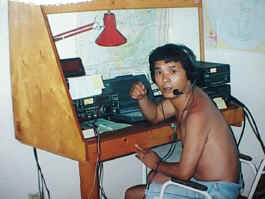
VP5/JJ1BMB is operating Satellite.@@@VP5/JM1GYQ
Mr.Okamoto.
How to get the license in VP5
First of all, the operation in VP5 requires a license for any
operator from the outside of VP5. This section describes how to get the license for JA
stations. The applicant who wants to get the license must provide, 1) a Xerox copy of JA
operator license (So-called gMusen Juhjisya Menkyoh) and station license ( gKyoku-Menh) each, 2) English translation of these license by the
communication administer of Japan (so-called gDen-Kanh).
To step ahead, the applicant should get the application
form of English translation at JARL in Sugamo, Tokyo. Please note the English translation
takes approx. 4 weeks. The purpose of operating, how to use, the place (country) that the
applicant would like to QRV, QTH and due must be filled in this form. Now you are all set.
With this form, the above copies must be submitted to the administration office in VP5. In
general, the acquaintance and/or friend in VP5 might be needed to take care of this
application. This situation will be more convenient for the applicant to get the license.
This will absolutely save a time to process the paperwork and get you the license.
The application needs US$21 to process. Mr. Okamoto, a
partner of this excursion, sent an entire set of application to his friend in VP5, so that
he could take care of. In two weeks after mailing out of Japan, we got a fax from the
friend, telling gour application was all done.h
This fax lead us to make the final decision of this excursion
to execute at any rate. We could not make any clear decision until we got this fax, since
we were worried about the penalty of cancellation fee of this trip, that is, a big amount
of money to the travel agent to be paid. Once we made a decision, we have arranged a
flight and hotel reservation as quickly as possible like an arrow. Our major goal was to
enjoy DXfing in VP5 rather than a sight seeing up
there.
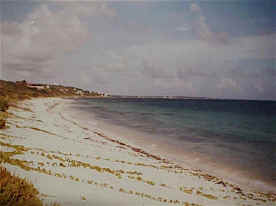
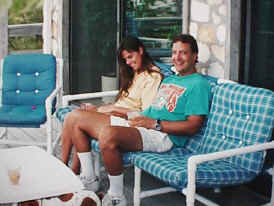
Wow, Nice view of Turks & Caicos Is.@@@@Jody's
daughter and her husband Karl.
Piling -up
We have really enjoyed QSO in a big pile up on either 20 m or
15 m band, since a lot of US and European stations were watching in these major DX bands.
In a several minutes after we called up gCQh, we got a huge number of callings from them, making a pile up
instantly. This heavy piling up did not bother us under the heat of the weather or by a
lizard climbing up over my leg sometimes at all, though, getting everyone back a g599++h report in a few hours
made us so exhausted and brought us a pain. To decrease the running rate of QSO, we have
intentionally turned down the RF output. However, we got the real pleasure of dealing with
pile up in Caribbean island in a HAM life.
QSO logging & CW operation
Among the stuff that we brought here from Japan, I would like
to show you some software tool worked efficiently in this trip. gCT DX Pedition modeh was
really useful for logging QSO and CW operation. At my shack, the CT program was loaded
into IBM-PC clone using 486/66MHz, as well as CC98 for RTTY and Geoclock running in
parallel, showing three independent windows on a 17 inch-color monitor. This configuration
works really nice to watch DX signals and to hunt at my shack. Furthermore, this features
to make instantly a summary of the total QSO, worked country and zone, allowing us to be
fun and to save a lot of time of filing and sorting QSO and duplication of QSO as well. To
make it matters good, this software features a printing capability of QSL label and a QSO
list. This works really nice. So this software as well as ga electronic Keyh and ga head seth might be the best
tools to deal with pile up of QSO.
Suppose if I would get a lap top PC with AT expansion
slot, where gDVPh was attached, then I could deal with a more heavier pile up than we
have done here in SSB mode. I should bring that with me if I would be here again in the
future.
By the way, I enjoyed a shopping in Atlanta on the way
back to Tokyo. I bought 5000 QSL labels in a row. The US10$ of price surprised me for
5000. Also I wished I could buy a cheap PC with 383/33MHz dedicating to run gCTh program in addition to my
current machine, though I gave up to buy that since I have worried about the excess of
check in baggage weight. It was my great regret that I should buy at least a CPU and a
motherboard.
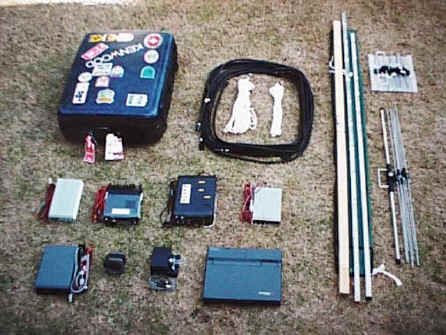
All Equipments for VP5/JJ1BMB
(UHF and VHF Tranceiver, UHF Linear Amplifier, Pre-Amplifier,
RTTY TU, Keyer, PC, Antenna Cable, UHF and VHF Antenna).
A life in Caicos Island
Food and drink are the must to prepare daily in this
excursion. In a daily basis, we took sandwich and corn frake prepared by Mr. Okamoto, and
a boiled water, coke and a beer for a drink instead of a natural water available in the
island. During the stay, we enjoyed once to taste a lobster dinner with Jody, her daughter
and her husband, which cost only US$20 per person. The taste of lobster, since it is come
from Caribbean sea right in front of our shack, was really nice and fresh, and big enough
compared to gIse-Ebih, a Japanese lobster which is more expensive than that. You might
pay at least US$50 per person for a dish in Japan.
Air conditioned room was not available at our site we
explored here, so a steamy night and a mosquito bothered us to sleep well, but awoke up
early morning without a alarm clock. Thus, we were never late to miss the chance of the
band opening in the morning.
Paul, an employee of Jodyfs home, wondered while he was watching us to enjoy a pleasure of
QSO through a radio, and asked us gWhat the hell are
you guys doing here, doing some business ?h It
seemed him that we were very strange Orientals came from Japan, since we were building an
antenna, sitting around the transceiver all day long rather than swimming, relaxing and so
on.
In the last evening before going home, we were invited a
dinner at Jodyfs home and have chatted with Jody and
her family with her home-made gKiwee-Lime Pieh. During this conversation after diner, Jody asked us and wanted us
to give her our advise on choosing a comfortable rig and other stuffs for the satellite
communication, showing us a catalog. She had a plan to buy some stuff in Dayton next year.
Since we are beginners of satellite communication, so I replied her that I will ask JA1CG
for you to get his advice. Sorry OM!. In addition to the satellite communication, she
would like to build a new tower with a 75m band antenna next year. I wished she could
complete such stuff.
QSO Results
| BAND |
CW |
SSB |
RTTY |
SUM |
| 160 |
0 |
0 |
0 |
0 |
| 80 |
116 |
36 |
0 |
152 |
| 40 |
232 |
1 |
0 |
333 |
| 30 |
744 |
0 |
0 |
744 |
| 20 |
369 |
309 |
6 |
684 |
| 17 |
540 |
0 |
0 |
540 |
| 15 |
569 |
181 |
0 |
750 |
| 12 |
11 |
0 |
0 |
11 |
| 10 |
4 |
0 |
0 |
4 |
| SAT |
77 |
151 |
0 |
228 |
| ALL |
2662 |
678 |
6 |
3346 |
*1. DETAIL OF SATELLITE: CW:78 QSO(44JAs)¤ SSB:150 QSO(42JAs)
*2. VP5/JM1GYQ:1,323 QSO¤ VP5/JJ1BMB:2,023 QSO
Acknowledgement
I greatly appreciate the following people to execute our
vacation plan to enjoy DXfing in Caribbean Islands,
giving their hospitality, courtesy and their great help;
NW4F, Mr. Tyson & Mrs. Tyson for the
stay at their home in Atlanta. VP5JM, Jody for borrowing me a satellite
antenna and a dinner. JA1CG, Mr. Takahashi for the special lesson of
satellite communication as well as picking us at the station in the heavy rain due to a
typhoon. JA1ELY, Mr. Kusano, g59h
magazine editor for borrowing me his DC power supply for this
DXfing and delivering our plan via his magazine. JA8VE,
Mr. Saito & JA1TRC, Mr. Oka of JARL international group for the paper
work to get a license in VP5. JR1QQG, Mr. Nose for borrowing me his newly
purchased TS-50 and JF1VJW, Mr. E-izumi for tips of travel in abroad.
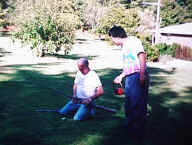
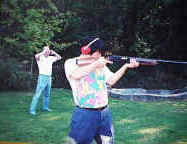
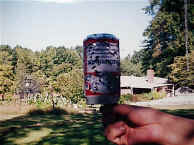
NW4F Mr.Tyson and JJ1BMB in U.S.A.
Return to the Ham House Top Page















